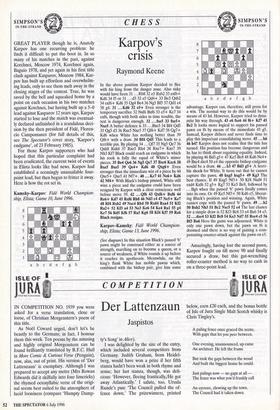SIMPSON'S
IN•THE•STRAND
SIMPSON'S
IN-THE-STRAND
CHESS
Karpov's crisis
Raymond Keene
GREAT PLAYER though he is, Anatoly Karpov has one recurring problem: he finds it difficult to put the boot in. In so many of his matches in the past, against Korchnoi, Moscow 1974, Korchnoi again, Baguio 1978, and yet again in his first title clash against Kasparov, Moscow 1984, Kar- pov has built up effortless and overwhelm- ing leads, only to see them melt away in the closing stages of the contest. True, he was saved by the bell and squeaked home by a point on each occasion in his two matches against Korchnoi, but having built up a 5-0 lead against Kasparov 12 years ago, Karpov started to lose and the match was eventual- ly declared unfinished in a scandalous deci- sion by the then president of Fide, Floren- cio Campomanes (for full details of this, see The Spectator's cover story, `Karpov's endgame', of 23 February 1985).
For those Karpov supporters who had hoped that this particular complaint had been eradicated, the current twist of events in Elista looks like bad news. Karpov had established a seemingly unassailable four- point lead, but then began to fritter it away. Here is how the rot set in.
Kamsky—Karpov: Fide World Champion- ship, Elista; Game 10, June 1996. In the above position Karpov decided to flee with his king from the danger zone. Also risky would have been 31 ... Rb8 32 e5 Rxb2 33 exf6+ Kd6 34 f5 or 31 —le 32 e5 Qd4+ 33 Be3 Qxb2 34 exf6+ Kd6 35 Qg4 Be4 36 Ng5 Bf5 37 Qd1 c4 38 g4. 31 ...Kd6 32 e5+ Even stronger is the temporary sacrifice 32 Nxf6 Bxf6 33 e5+ Kc7 34 exf6, though with both sides in time trouble, the text is dangerous enough. 32 ...txe5 33 fxe5+ Nxe5 A better defence is 33 ... Bxe5 34 Bf4 Qd5
35 Qg5 d3 36 RxeS Nxe5 37 Qf6+ Kd7 38 Qg7+ Kd6 when White has nothing better than 39 Qf6+ with a draw. 34 Bf4 Qd5 This leads to a terrible pin. By playing 34 ... Qt7 35 Ng5 Qe7 36 Qxh8 Rxh8 37 RxeS Rh4 38 Rxe7+ Kxe7 39 Nh3 Kf7 Black could reach an endgame in which his rook is fully the equal of White's minor pieces. 35 Be4 Qe6 36 Ng5 Qe7 37 Bxc6 Kxc6 38 Bxe5 Bxe5 39 Qe4+ Kd6 40 Qxg6+ Even stronger than the immediate win of a piece by 40 QxeS+ Qxe5 41 Nf7+. 40 ...Kc7 41 Ne6+ Kd6 42 Nf4+ With Black's bishop pinned, White still wins a piece and the endgame could have been resigned by Karpov with a clear conscience well before move 59. 42 ...Qf6 43 Qxf6+ Bxf6 44 Re6+ Kd7 45 Rxf6 Rb8 46 Nd3 c4 47 Ne5+ Ke7 48 Rf4 Rxb2 49 Nxc4 Rb4 50 Rxd4 Rxe4 51 Kf2 Ra2+ 52 103 a4 53 Ne3 Ke6 54 Ke4 Ral 55 g4 Ke7 56 Rd5 1Cf6 57 Ra5 Kg6 58 Kf4 Kf7 59 Ran Black resigns.
Karpov—Kamsky: Fide World Champion- ship, Elista; Game 13, June 1996.
(See diagram) In this situation Black's passed pawn might be construed either as a source of strength, marching on to become a queen, or a source of weakness, if White rounds it up before it reaches its apotheosis. Meanwhile, on the king's flank White has mobile pawns which, combined with the bishop pair, give him some
advantage. Karpov can, therefore, still press for a win. The normal way to do this would be by means of 43 h4. However, Karpov tried to dyna- mite his way through. 43 e6 fxe6 44 f6+ K17 45 Bc2 It looks more logical to support his passed pawn on f6 by means of the immediate 45 g5. Instead, Karpov dithers and never finds time to play this important consolidating move. 45 ...h6 46 h47 Karpov does not realise that the tide has turned. His position has become dangerous and he has to think about regaining equality. Indeed, by playing 46 Bd3 g5+ 47 Ke5 Be8 48 Kd6 Nc4+ 49 Bxc4 dxc4 50 e4 the opposite bishop endgame would be a draw. 46 ...b3 47 Bd3 g5+ A horri- ble shock for White. It turns out that he cannot capture the pawn. 48 hxg5 hxg5+ 49 Kg3 The best chance. If 49 KxgS Nf3+ 50 Kf4 Nxd4 51 exd4 Kxf6 52 g5+ Kg7 53 Ke5 Be8, followed by ...Bg6 when the passed 'b' pawn finally comes into its own. Or 49 Ke5 Nf3+ 50 Kd6 e5, liberat- ing Black's position and winning. Again, White cannot cope with the passed 'b' pawn. 49 ...b2 50 Bxb2 Nb3 51 Bc2 NxcS 52 e4 The last chance for a simple draw is 52 Kf3 Bc8 53 e4 Ba6 54 e5. 52 ... dxe4 53 Kf2 Bc8 54 Ke3 Nd7 55 Bxe4 c5 56 Bf3 Ba6 Here the game was adjourned. White is only one pawn down, but the pawn on f6 is doomed and there is no way of gaining a com- pensating counter-attack against the pawn on c5.
Amazingly, having lost the second pawn, Karpov fought on till move 90 and finally secured a draw, but this gut-wrenching roller-coaster method is no way to cash in on a three-point lead.


























































 Previous page
Previous page